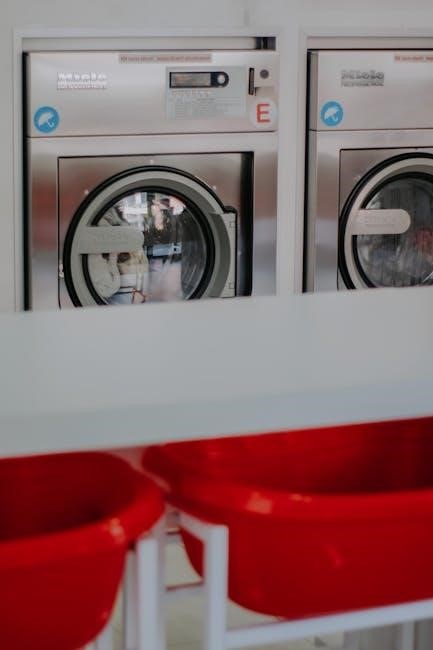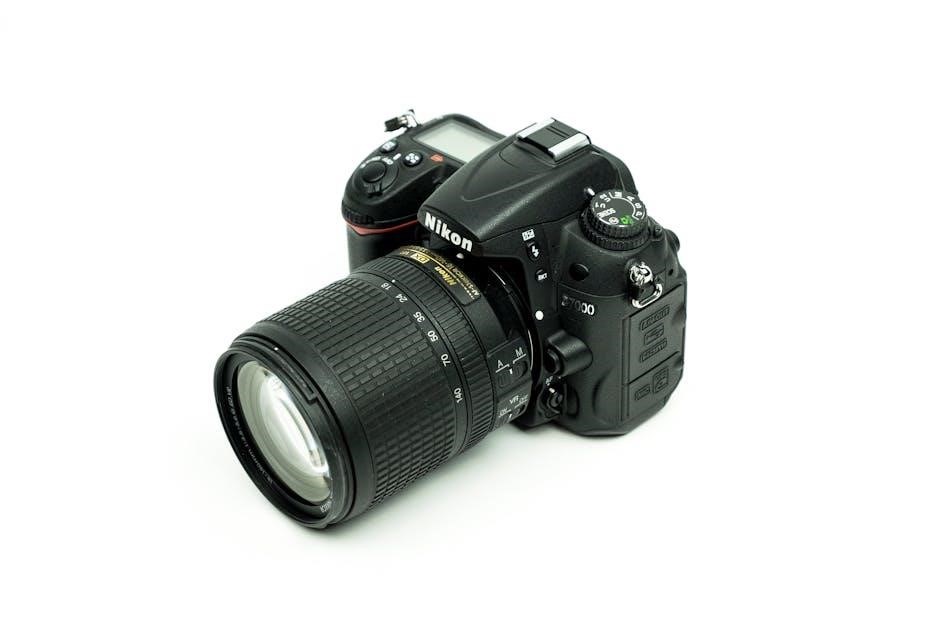Welcome to the GE Spacemaker Washer Dryer Manual, your comprehensive guide for installing, operating, and maintaining the GE Spacemaker washer/dryer. This manual covers models like WSM2700H and WSM2420S, providing detailed instructions for optimal performance and safety. Discover installation tips, cycle selections, and maintenance routines to ensure your appliance runs efficiently. Reading this manual is essential for troubleshooting and extending the lifespan of your unit.
Overview of the GE Spacemaker Washer Dryer
The GE Spacemaker Washer Dryer is a compact, unitized appliance designed for space-saving convenience. Models like the WSM2700H and WSM2420S combine a washer and dryer in one unit, ideal for small households or limited spaces. These appliances feature a stackable design, allowing the washer to be placed on top of the dryer, maximizing floor space. The GE Spacemaker series is known for its efficiency and versatility, offering multiple wash and dry cycles to cater to various fabric types. With a focus on practicality, these units are perfect for apartments, condos, or laundry areas with restricted dimensions. The GE Spacemaker Washer Dryer is engineered to provide reliable performance while fitting seamlessly into compact living environments, making it a popular choice for modern homeowners seeking functionality without sacrificing space.
Key Features of the GE Spacemaker Washer Dryer
The GE Spacemaker Washer Dryer offers a range of innovative features designed for convenience and efficiency. Models like the WSM2700H and WSM2420S boast a unitized design, combining a washer and dryer in a single compact unit. This space-saving configuration is ideal for small households or tight spaces. The appliance features multiple wash and dry cycles, allowing users to customize settings for different fabric types. Additionally, the GE Spacemaker includes a stackable design, enabling the washer to be placed on top of the dryer for maximum space utilization. Energy efficiency and quiet operation are also key highlights, making it suitable for everyday use. The dryer includes a lint filter for safety and maintenance, while the washer offers a stainless steel basket for durability. These features make the GE Spacemaker Washer Dryer a practical and reliable choice for modern laundry needs.
Importance of Reading the Manual
Reading the GE Spacemaker Washer Dryer Manual is essential for understanding how to properly install, operate, and maintain your appliance. The manual provides detailed instructions for models like the WSM2700H and WSM2420S, ensuring safe and efficient use. It covers critical information such as venting requirements, electrical connections, and fabric care guidelines. By following the manual, you can avoid common mistakes that may lead to malfunctions or safety hazards. Additionally, the manual includes troubleshooting tips to help diagnose and resolve issues quickly. It also offers guidance on maintaining the appliance, such as cleaning the lint filter and checking dryer vents. Reading the manual thoroughly will help you maximize the performance and lifespan of your GE Spacemaker Washer Dryer while ensuring a safe and convenient laundry experience.

Installation Guidelines
Proper installation of the GE Spacemaker Washer Dryer is crucial for safe and efficient operation. Follow the manual’s instructions for models like WSM2700H and WSM2420S to ensure compliance with safety standards and optimal performance.
Pre-Installation Requirements
Before installing the GE Spacemaker Washer Dryer, ensure your space meets specific requirements. The unit must fit in the designated area, leaving enough clearance for proper ventilation and maintenance. Check the electrical setup to confirm compatibility with the appliance’s power needs, typically requiring a dedicated 120V circuit. Ensure the dryer venting system is installed correctly, avoiding flexible plastic materials and using UL-listed ducts if metal flexible ducts are used. Verify water supply lines are accessible and free from leaks or damage. Review the manual for specific model requirements, such as those for WSM2700H or WSM2420S. Proper preparation ensures a safe and efficient installation process. Always consult the manual for detailed guidelines to avoid potential issues during setup.
Connecting the Washer and Dryer
Connecting the GE Spacemaker Washer Dryer requires careful attention to ensure proper functionality and safety. For the washer, connect the water supply lines to the designated ports, ensuring they are securely attached and free from leaks. The dryer must be connected to a venting system that meets safety standards, avoiding flexible plastic materials. Use UL-listed ducts if flexible metal ducts are installed, following the manual’s guidelines. Ensure the dryer vent is properly aligned with the exterior vent to prevent lint buildup and fire hazards. Refer to the manual for specific instructions, such as those for models like WSM2700H or WSM2420S. Proper connections are crucial for efficient operation and to prevent potential malfunctions. Always double-check connections before powering on the appliance.
Venting Requirements for the Dryer
Proper venting is essential for the safe and efficient operation of the GE Spacemaker Dryer. The dryer must be vented to the outdoors using a rigid metal vent pipe or a UL-listed flexible metal duct. Flexible plastic venting materials are strictly prohibited due to fire hazards. If using flexible metal ducts, ensure they are UL-listed and installed according to the manual’s instructions. The vent system should be as short and straight as possible to minimize airflow restriction. Regularly inspect and clean the vent to remove lint buildup, which can cause inefficiency or fires. The vent cap should be at least 12 inches above the ground and protected from obstruction by snow, debris, or screen coverings. Proper venting ensures optimal performance, energy efficiency, and safety. Always follow the manufacturer’s guidelines for venting requirements to avoid potential hazards and maintain warranty validity.
Electrical Connections
Ensure the GE Spacemaker Washer Dryer is connected to a dedicated 120V or 240V electrical circuit, depending on the model specifications. The dryer typically requires a higher voltage, so verify the manual for exact requirements. Avoid using extension cords, as they can cause power issues or safety hazards. The electrical connection must be properly grounded to prevent shocks or malfunctions. If unsure, consult a licensed electrician to install the correct wiring. Always follow the manufacturer’s guidelines for electrical connections to ensure safe and efficient operation. Regularly inspect the power cord for damage and replace it if necessary. Never overload the circuit, as this can lead to electrical fires or damage to the appliance. Refer to your specific model’s manual for detailed electrical connection instructions to maintain safety and warranty compliance.

Operating Instructions
Follow the GE Spacemaker Washer Dryer Manual for selecting cycles, using fabric softeners, and special fabric care. Ensure the lint filter is in place before drying for optimal performance and safety.
Washer Cycle Selection
Selecting the right washer cycle on your GE Spacemaker is essential for optimal cleaning. Choose from options like delicate, normal, or heavy-duty cycles based on fabric type and soil level. For tough stains, use the soak function by stopping the cycle and letting garments soak before completing the wash. Always refer to the Controls Setting Guide in the manual for specific cycle details. Fabric softeners can be added during the wash cycle, following the manufacturer’s instructions. For delicate fabrics, select the gentle cycle and ensure items are rinsed thoroughly. Remember to check fabric care labels for special instructions. Proper cycle selection ensures efficient cleaning and protects your clothes from damage. Follow the manual’s guidelines for best results and to maintain your washer’s performance.
Dryer Cycle Selection
Selecting the appropriate dryer cycle on your GE Spacemaker ensures efficient drying and fabric protection. Choose from options like delicate, normal, or heavy-duty cycles based on fabric type and moisture levels. For best results, use dryer-added products as recommended by manufacturers, ensuring they are safe for your dryer. Always clean the lint filter before each use to maintain airflow and efficiency. Regularly check and clean the dryer vent to prevent blockages and ensure proper drying. For delicate fabrics, select the low-heat setting to avoid damage. Refer to the Controls Setting Guide in the manual for specific cycle details. Proper cycle selection helps conserve energy and extends the life of your fabrics. Never operate the dryer without the lint filter in place, as this can lead to poor performance or safety hazards. Follow the manual’s guidelines for optimal drying results and appliance longevity.
Using Fabric Softeners and Dryer Sheets

For optimal fabric care, the GE Spacemaker washer/dryer allows the use of fabric softeners and dryer sheets. Add fabric softeners during the wash cycle, following the product’s instructions. For dryer sheets, place one in the dryer drum before starting a cycle to reduce static and freshen fabrics. Ensure dryer sheets are safe for dryer use, as specified by their manufacturers. Avoid using products that could damage fabrics or the appliance. Do not use flexible plastic venting materials, as they are not recommended for dryer installation. Proper venting is crucial for efficient drying and safety. Always follow the guidelines in the manual for using fabric softeners and dryer sheets to maintain performance and prevent potential hazards. Regular cleaning of the lint filter and vent ensures optimal airflow and safety during drying cycles. Proper use of these products enhances fabric softness and freshness while maintaining your appliance’s efficiency.
Special Care Instructions for Fabrics
When using the GE Spacemaker washer/dryer, special care is needed for delicate or sensitive fabrics. For wool, silk, or lingerie, select the delicate cycle with cold water to prevent damage. Avoid overloading the washer, as this can cause excessive wear on fabrics. For heavily soiled items, pre-treat stains before washing. When drying, remove delicate fabrics as soon as the cycle ends to prevent wrinkling. Use a low heat setting for fabrics like rayon or nylon to avoid shrinkage. Do not dry wool or silk in the dryer; air-dry them instead. Always check fabric labels for specific care instructions. For items with beads or sequins, use a mesh laundry bag to protect them during washing. By following these guidelines, you can ensure your fabrics remain in great condition while using the GE Spacemaker washer/dryer. Proper care extends the life of your clothing and maintains their quality.

Maintenance and Care
Regular maintenance ensures optimal performance of your GE Spacemaker washer/dryer. Clean the washer tub monthly and check dryer vents for lint buildup. Replace filters as needed to maintain efficiency and safety.
Cleaning the Washer and Dryer

Regular cleaning is essential to maintain the performance and longevity of your GE Spacemaker washer and dryer. For the washer, run a cleaning cycle monthly using a washer cleaner or 1 cup of white vinegar on a hot water setting. After washing, leave the lid open to dry the interior and prevent mildew. For the dryer, clean the lint filter after each use and check the venting system for blockages. Use a soft brush or vacuum to remove lint buildup in the dryer vent, ensuring proper airflow. Additionally, wipe down the exterior with a damp cloth and mild detergent to keep it looking clean. Regular maintenance helps prevent odors, reduces energy consumption, and ensures safe operation of your GE Spacemaker appliance.
Removing Lint from the Dryer Vent
Regularly cleaning lint from the dryer vent is crucial for safety and efficiency. Turn off and unplug the dryer before starting. Disconnect the vent from the dryer and use a vacuum cleaner or a brush to remove accumulated lint. Check the entire venting system for blockages, as clogged vents can cause fires and reduce performance. Flexible metal ducts must be UL-listed and installed according to the manual. Avoid using plastic venting materials, as they are not safe. After cleaning, reconnect the vent securely to ensure proper airflow. For tough blockages, consider professional cleaning annually. Keeping the dryer vent lint-free helps maintain optimal performance, reduces energy consumption, and prevents potential hazards. Always follow the manufacturer’s guidelines for venting materials and maintenance to ensure safe and efficient operation of your GE Spacemaker dryer.
Replacing Parts and Filters
Replacing parts and filters in your GE Spacemaker washer/dryer is essential for maintaining performance and longevity. Always use genuine GE replacement parts to ensure compatibility and safety. Start by identifying the worn-out or damaged components, such as the lint filter, belts, or gaskets. Refer to the manual for specific part numbers and diagrams. Turn off and unplug the appliance before beginning any replacement. For the dryer, the lint filter should be cleaned after each use and replaced if damaged. Regularly inspect and replace the dryer venting system to prevent blockages. Follow the manual’s instructions for disassembling and reassembling components. Properly dispose of old parts and recycle if possible. Replacing parts promptly helps avoid further damage and ensures efficient operation. Always double-check connections and test the appliance after completing repairs to ensure everything functions correctly.

Troubleshooting Common Issues

Troubleshooting your GE Spacemaker washer/dryer involves identifying common issues like error codes, lint buildup, or poor performance. Refer to models like WSM2700H or WSM2420S for specific solutions. Check for blockages in vents, ensure proper electrical connections, and verify cycle selections. Clean the lint filter regularly and inspect belts for wear. If issues persist, consult the manual for diagnostic guides or contact GE support for professional assistance. Regular maintenance can prevent many problems, ensuring efficient operation and extending the appliance’s lifespan. Always follow safety precautions when troubleshooting to avoid further damage or hazards.
Diagnosing Washer Problems
Diagnosing issues with your GE Spacemaker washer involves checking for common problems like error codes, poor performance, or unusual noises. Start by ensuring the washer is properly plugged in and the circuit breaker isn’t tripped. Check the water supply lines for kinks or blockages and verify that the water valves are fully open. If the washer doesn’t drain, inspect the drain hose for kinks or clogs. For models like WSM2700H or WSM2420S, consult the manual for specific error code meanings. If the washer vibrates excessively, ensure it’s level and balanced. Refer to the troubleshooting section in the manual for guidance on resolving issues like improper detergent use or fabric damage. Always follow safety precautions when diagnosing and repairing to avoid further damage or injury.
Resolving Dryer Malfunctions
Resolving issues with your GE Spacemaker dryer begins with identifying common malfunctions such as the dryer not heating, failing to turn on, or making unusual noises. First, ensure the dryer is properly plugged in and the circuit breaker hasn’t tripped. Check the lint filter and venting system for blockages, as restricted airflow can cause poor performance. If the dryer doesn’t heat, verify that the gas supply (for gas models) is turned on or that the electrical connection is stable. Refer to the manual for specific error codes, which can guide you to the root cause. Clean the venting system regularly to prevent lint buildup, and ensure all connections are secure. For models like WSM2700H or WSM2420S, consult the troubleshooting section for detailed solutions. Always follow safety guidelines when addressing malfunctions to avoid further damage or hazards.

Safety Precautions
Always follow safety guidelines when using the GE Spacemaker Washer Dryer. Ensure proper installation, avoid flexible plastic venting, and use UL-listed materials. Keep the area clear of flammable items and refer to the manual for detailed safety instructions.

General Safety Guidelines
Adhering to safety precautions is crucial when operating the GE Spacemaker Washer Dryer. Always follow the manufacturer’s instructions to ensure safe and efficient use. Proper installation is essential, and the area around the appliance should be kept clear of flammable materials. Never use flexible plastic venting for the dryer, as it poses a fire hazard. Instead, use UL-listed materials and follow the venting guidelines provided in the manual. Additionally, avoid overloading the washer or dryer, as this can lead to imbalance and potential damage. Keep children away from the appliance while it is in operation, and ensure they understand the risks of tampering with controls. Regularly clean the lint filter and vent to prevent fires. Never operate the dryer without the lint filter in place, as this can cause overheating. By following these guidelines, you can ensure a safe and trouble-free experience with your GE Spacemaker Washer Dryer.
Child Safety Features
The GE Spacemaker Washer Dryer includes essential child safety features to prevent accidents and ensure safe operation. A key feature is the child lock, which can be activated to prevent unintended changes to settings or cycles. This ensures that children cannot accidentally start or stop the appliance. Additionally, the secure lid design minimizes the risk of children accessing the washer or dryer during operation. Parents are advised to supervise children when the appliance is in use and teach them about the dangers of tampering with controls. The manual also recommends installing the unit in a location that is out of children’s reach. By utilizing these safety features and following the guidelines outlined in the manual, you can create a safer environment for your family while using the GE Spacemaker Washer Dryer.
The GE Spacemaker Washer Dryer Manual provides essential guidance for optimal performance, safety, and maintenance. By following the instructions, users can ensure efficient, safe, and durable operation of their appliance.
Final Tips for Optimal Performance
For the best results with your GE Spacemaker Washer Dryer, regular maintenance is key. Always clean the lint filter after each dryer use and ensure proper venting to prevent blockages. Use fabric softeners or dryer sheets as recommended to maintain fabric quality. Avoid overloading the washer or dryer, as this can reduce efficiency and cause damage. Select the appropriate cycles for your laundry needs, and refer to the manual for specific fabric care instructions. Keep the exterior and interior clean to prevent dust buildup. If issues arise, consult the troubleshooting section before contacting a technician. Lastly, ensure all electrical connections and installations meet the manual’s guidelines for safe operation. By following these tips, you’ll extend the lifespan of your appliance and enjoy optimal performance.
Where to Find Additional Resources
For further assistance with your GE Spacemaker Washer Dryer, visit the official GE Appliances website, where you can download PDF manuals for models like WSM2700H and WSM2420S. These resources include detailed use and care guides, installation instructions, and troubleshooting tips. Additionally, websites like ManualsLib and ManualsOnline offer free access to user manuals and technical specifications. If you have specific questions, refer to the GE customer support page for contact information or live chat options. Community forums and YouTube tutorials also provide practical insights and user experiences. Ensure you only use authorized resources to maintain your appliance’s warranty and safety standards. By exploring these resources, you can maximize your understanding and enjoyment of your GE Spacemaker Washer Dryer.




About the author